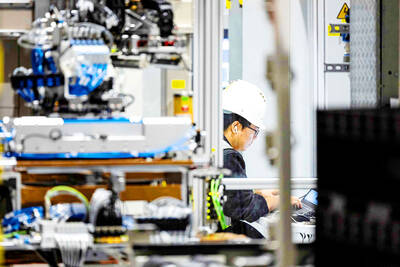LG Electronics Inc, the world’s third-largest maker of liquid-crystal-display (LCD) televisions, aims to overtake Sony Corp as the second-biggest this year, driven by stronger-than-expected demand.
The company is maintaining its LCD TV-shipment target of 18 million units for this year, which will be achievable, Simon Kang, head of the company’s home-entertainment division, told reporters in Seoul yesterday.
Global revenue from LCD TVs will drop 6 percent this year to US$76 billion, researcher DisplaySearch said last week, higher than its previous estimate of US$66 billion. Worldwide LCD TV shipments will rise 21 percent to 127 million units, compared with an earlier prediction of 120 million, because of higher demand from China and as more consumers replace bulkier glass-tube sets, according to the Austin, Texas-based research firm.
The South Korean company yesterday introduced its latest LCD TVs using light-emitting diodes (LEDs) as backlights instead of conventional fluorescent lights.
Global shipments of LCD TV panels with LED backlights will increase to 3.3 million units this year compared with 438,000 last year, according to researcher iSuppli Corp this month.
LED backlights, illuminated by glowing chips and used in products such as Apple Inc’s laptop computers, are brighter and consume less power than conventional fluorescent tubes.
LG expects global shipments of LCD TVs with LED backlights to rise almost 10-fold to 30 million units next year from 3.1 million this year. The firm aims to sell 400,000 sets this year and 3 million to 4 million units next year.

CHIP RACE: Three years of overbroad export controls drove foreign competitors to pursue their own AI chips, and ‘cost US taxpayers billions of dollars,’ Nvidia said China has figured out the US strategy for allowing it to buy Nvidia Corp’s H200s and is rejecting the artificial intelligence (AI) chip in favor of domestically developed semiconductors, White House AI adviser David Sacks said, citing news reports. US President Donald Trump on Monday said that he would allow shipments of Nvidia’s H200 chips to China, part of an administration effort backed by Sacks to challenge Chinese tech champions such as Huawei Technologies Co (華為) by bringing US competition to their home market. On Friday, Sacks signaled that he was uncertain about whether that approach would work. “They’re rejecting our chips,” Sacks

NATIONAL SECURITY: Intel’s testing of ACM tools despite US government control ‘highlights egregious gaps in US technology protection policies,’ a former official said Chipmaker Intel Corp has tested chipmaking tools this year from a toolmaker with deep roots in China and two overseas units that were targeted by US sanctions, according to two sources with direct knowledge of the matter. Intel, which fended off calls for its CEO’s resignation from US President Donald Trump in August over his alleged ties to China, got the tools from ACM Research Inc, a Fremont, California-based producer of chipmaking equipment. Two of ACM’s units, based in Shanghai and South Korea, were among a number of firms barred last year from receiving US technology over claims they have

It is challenging to build infrastructure in much of Europe. Constrained budgets and polarized politics tend to undermine long-term projects, forcing officials to react to emergencies rather than plan for the future. Not in Austria. Today, the country is to officially open its Koralmbahn tunnel, the 5.9 billion euro (US$6.9 billion) centerpiece of a groundbreaking new railway that will eventually run from Poland’s Baltic coast to the Adriatic Sea, transforming travel within Austria and positioning the Alpine nation at the forefront of logistics in Europe. “It is Austria’s biggest socio-economic experiment in over a century,” said Eric Kirschner, an economist at Graz-based Joanneum

France is developing domestic production of electric vehicle (EV) batteries with an eye on industrial independence, but Asian experts are proving key in launching operations. In the Verkor factory outside the northern city of Dunkirk, which was inaugurated on Thursday, foreign specialists, notably from South Korea and Malaysia, are training the local staff. Verkor is the third battery gigafactory to open in northern France in a region that has become known as “Battery Valley.” At the Automotive Energy Supply Corp (AESC) factory near the city of Douai, where production has been under way for several months, Chinese engineers and technicians supervise French recruits. “They